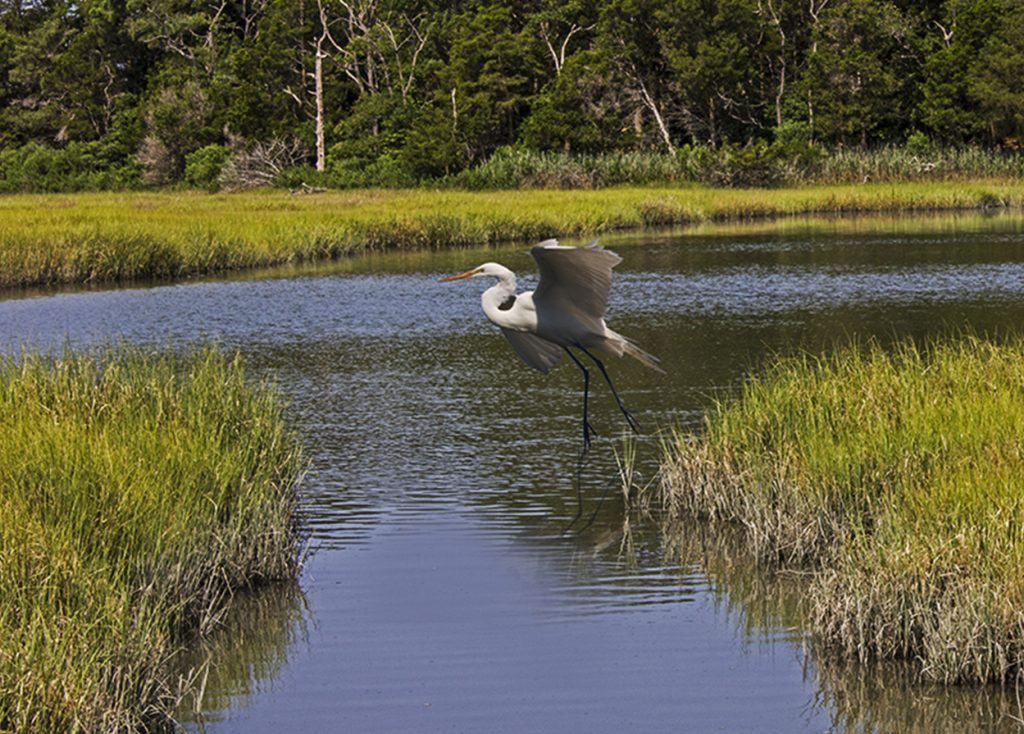Whether at the full light of day or under a sunset’s golden sky, gazing out at a tidal creek meandering through a salt marsh’s river of grass can be captivating. As the waters recede toward low tide, wide patches of mud flats are uncovered. They often surround stands of smooth cordgrass that in the distance, can take on the appearance of small islands. The tidal creeks are lined with tall cordgrass that sway in a gentle breeze. In the high marsh areas, the shorter saltmeadow cordgrass (saltmarsh hay) produce cowlicks, taking on a beauty of their own.

Beyond their appeal, tidal salt marshes are a tremendous asset for nature and humanity. They rank among the world’s most diverse and productive ecosystems. They function as a food source, refuge and/or nursery for more than 75 percent of fisheries species that include grass shrimps, crabs and a variety of finfishes. As water flows through salt marshes, they improve its quality by removing pollutants such as pesticides, herbicides and excess nutrients. They also serve as an important buffer against storm waves and surges, protecting the shoreline from erosion and human habitats farther inland.
Tidal salt marshes form in sheltered areas, away from heavy ocean waves where rivers and creeks deposit fine sediments forming mud flats. Portions of these marshes are exposed at low tide and partially flooded at high tide. The plants growing in this environment are salt resistant. In North America, salt marshes are found on every coast. Along the east coast, South Carolina has more acreage of salt marshes than any other state. The Gulf Coast is host to about 60 percent of all of the Nation’s salt marshes. Most of Long Island Sound’s salt marshes are found along coastal Connecticut. Guilford’s 800-acre East River Marsh is the Sound’s largest coastal wetland. Standing behind a two-mile long barrier beach, Stratford’s 421-acre Great Meadows Marsh is part of the Stewart B. McKinney National Wildlife Refuge. Divided among 10 separate sites, they are found along some 70 miles of Connecticut’s shorline. Eight of the refuges are islands.
Between the barrier beach and Great Meadows Marsh flows a body of water called Lewis Gut. Fed by Long Island Sound waters, freshwater creeks and runoff from the marsh, recreational fishermen have found it to be a great spot for catching bluefish, fluke, striped bass and sandbar sharks. The Gut is also frequently used by shell-fishermen as a seed area. Typical of other Connecticut tidal salt marshes, the sites are used as a spawning and/or nursery for at least 20 species of fish. It is estimated the larger marshes are hosts, at different times of the year, to approximately 270 different species of birds. Some of them are residents while others use the sites as a stop-over during their north-south migrations.
Exploring a salt marsh can be a great experience for children and adults. It can be done aboard a canoe, kayak, an inflatable dingy equipped with a small outboard engine or a small, flat-bottom boat also equipped with an outboard engine or a quiet electric trolling engine. Some also choose to walk a salt marsh. On foot, however, it is wise to wear knee-high rubber boots or waders. Always be aware that in some areas, the mud (peat) can be very soft, allowing you to sink deep into the mud!
By far, the best choice for exploration of the marsh is by boat. Depending on the size of the marsh, hours can be spent discovering its wonders while navigating its channels. A morning mid-tide (on a rising tide) is one of the best times to set out on your adventure. As you round a corner with an exposed mudflat, you may encounter large groups of fiddler crabs with males waving their claws or even a resident turtle, a diamondback terrapin basking in the sun. In the shallows, near a mud flat, killifish, chubs, silversides and sheepshead minnows may be seen swimming just below the surface. Throughout the area, also be on the lookout for a large variety of birds. Ospreys gaze out from their high perch or frequently hover overhead as they search for a next meal. Long-legged blue herons and great egrets are a graceful sight as they wade in the shallows and take to the sky to soar over the marsh. Oystercatchers with their attractive red-orange bill, search for a tasty clam or oyster. But many other equally interesting bird species can also be approached aboard a quiet boat. In the higher parts of the marsh, you might even encounter raccoons, muskrats or an occasional fox.
In addition to its varied marine life, avian resources and protection for our coast, salt marshes played another important role in the early history of our Nation. During the early colonies, marsh hay was used as animal feed and bedding. The pioneering colonies from Norwich, Connecticut to Portland, Maine were provided a portion of a salt marsh along with a home lot. At first, haying was done by hand using a long curved-bladed scythe. By the late 1800’s, they had been replaced by horse-drawn cutter bars. The cut marsh hay was then stacked above ground on wooden supports. Once dried, it was collected aboard flat-bottom boats called gundalows. For a time it is said that saltmarsh hay was the “backbone of Long Island’s economy.”
Tidal marshes continue to serve us with their vast benefits, allowing us to enjoy their beauty and appreciate them as ~ “Nature’s Gift Along our Sheltered Coast”.
